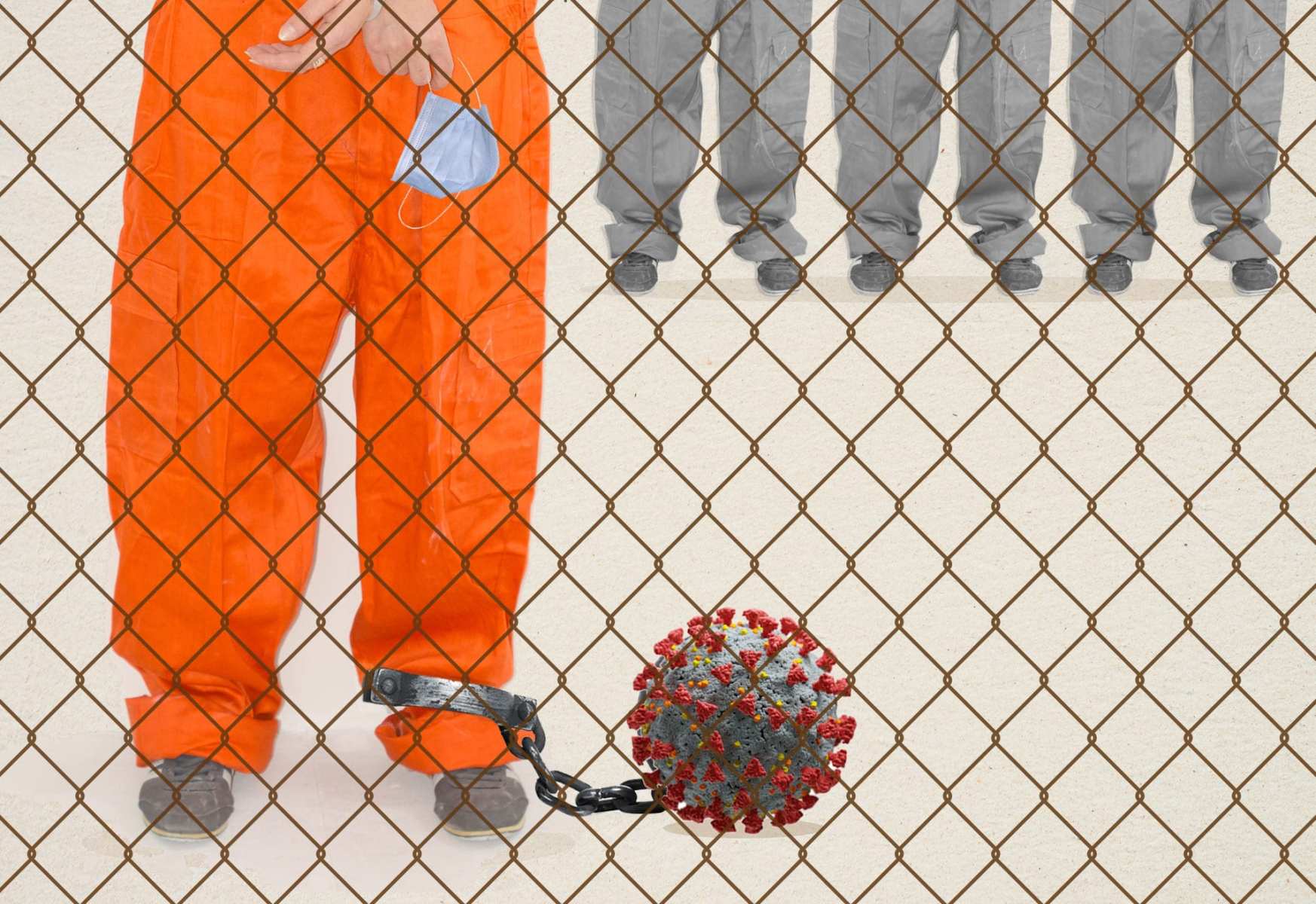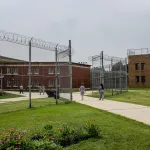Asia Johnson started noticing the changes during the first wave of the COVID-19 pandemic. Her regular phone calls with her friend Brittany became less frequent. And as months progressed, Brittany — “the happiest, most joyful” person Johnson met when they were incarcerated in Ypsilanti, Michigan — began sounding despondent.
“She is not the same person,” Johnson told The 19th. “It was easier before the pandemic to make it through the day because you could get access to programming, education … you got to have these social connections with people, but that’s being taken away.”
Johnson, who was released in 2018, is now a fellow with the Brennan Center for Justice, and through her work she has heard about similar challenges with isolation from other incarcerated women around the country.
COVID-19 has wreaked havoc on overcrowded jails and prisons, with the death rate for people inside prisons estimated to be about three times higher than the general population last summer. Facilities have also restricted visitation, wellness services and overall movement among incarcerated women, which often means they are confined to their cells nearly all day. Research published over the last few months is beginning to offer a more complete picture of how this reality is affecting incarcerated women nationally, but a lack of standardized reporting across corrections agencies means that significant gaps in the data remain.
Even prior to the pandemic, women were dying at rising rates, largely due to illnesses like cancer and heart disease. Between 2017 and 2018, the mortality rate among women in prisons increased by more than 37 percent, according to federal data. In jails, it increased by 8 percent during the same period.
Women are more likely than men to enter correctional facilities with mental illness and pre-existing health conditions, which not only raises their risk of COVID-19 complications but also makes them susceptible to significant psychological harm. As the Delta variant continues to spread, researchers told The 19th that they hope their findings will lead to more urgent action from officials.
Despite these challenges, officials made limited efforts to reduce incarcerated populations from releasing people from jails and prisons. The first half of 2020 saw an unprecedented decline in incarceration, with local jails experiencing the steepest drop. But these numbers began to increase again between mid- to late 2020, according to a report from the Vera Institute for Justice.
“A lot of executive orders required agencies to prioritize people for relief, who only had a certain number of months left on their sentence: three months, six months, nine months,” said Alycia Welch, associate director of the COVID, Corrections, and Oversight Project at the University of Texas at Austin. “You’re going to be looking at a smaller percentage of people when you’ve got those time constraints.”
Welch and her co-researcher Michele Deitch determined in a May report that these strict criteria often meant that many women were not eligible for the large-scale release that occurred early on in the pandemic because of the remaining time on their sentences.
Even particularly vulnerable populations, such as pregnant people, may not have been able to leave. Of the government agencies that made intentional efforts to release pregnant people from state prisons, the numbers amounted to a fraction of the thousands who are estimated to enter state prisons annually, Welch and Deitch found. Between March and May 2020, The Guardian reported that about 60 pregnant people across 10 states had been released from state prison facilities because of the pandemic.
Moving forward in this public health crisis, lawmakers and officials “need to take the steps necessary to help prevent people from getting sick. They have decarceration tools under their authority,” said Nicole D. Porter, director of advocacy for The Sentencing Project.
Beyond releasing people, Johnson said formerly incarcerated people need additional resources to help them with reentry into society, particularly during the pandemic. Prior to the pandemic, the overall unemployment rate for formerly incarcerated people was about 27 percent, and they were about 10 times more likely to be homeless, according to the Prison Policy Initiative. Formerly incarcerated women and LBGTQ+ people of color are more likely to face these hardships.
For women who remain incarcerated during the pandemic, the available data on infection and death rates is inconsistent between states and corrections agencies. More comprehensive figures could help inform decision makers as jail populations rise again alongside the ongoing threat of the virus.
A bill to improve how federal, state and local facilities report COVID data was introduced in the House and Senate this year but has not moved beyond congressional committees. In the absence of federal action, universities and news organizations have worked to gather such information.
Throughout the crisis, Erika Tyagi and her colleagues with UCLA Law Covid Behind Bars Data Project have published available numbers on COVID-19 infections, deaths and testing rates inside federal, state and local correctional facilities.
As part of her research, Tyagi said she hoped to produce an assessment of how the pandemic has affected women who remain incarcerated on a systemic level, but inconsistent reporting between state and federal agencies made that goal incredibly difficult. Some states like California publish more detailed information about COVID cases in each of the state’s facilities. Florida, however, groups COVID numbers in a way that makes it difficult for data scientists to pull out trends among specific groups, Tyagi said.
In an upcoming report focused on women, UCLA’s researcher found that across the nearly 80 state, federal, and county agencies, not a single prison, jail, or detention system consistently reported relevant COVID-19 health data explicitly broken down by gender.
Of the 107 state and federal women’s prisons that publicly posted data on cumulative COVID-19 cases, 52 reported more than 100 infections since March 2020, according to the team’s findings. But many other prisons and jails that house women do not report such information, so UCLA’s researchers estimate much higher infection rates among incarcerated women than what the report reflects.
“We’re entirely at the mercy of these departments of corrections that don’t really have any interest to report accurate and reliable data, and it’s really a long-standing problem that has led to the current moment,” said Joshua Manson, a researcher with the UCLA Law COVID Behind Bars Data Project.
Even without solid numbers, research and interviews with incarcerated women over the last 18 months has painted a bleak picture of life inside jails and prisons for women dealing with the fallout of the pandemic.
Women incarcerated at the Central California Women’s Facility told The 19th last year about their fears living in close quarters with people who had tested positive for COVID-19 and staff who in some cases refused to follow public health guidelines.
In other cases, women have been put in solitary confinement as a means of mitigating virus spread. Welch and Deitch at the University of Texas also found in their research that shortages of basic hygiene products, medical treatment, quality food and the suspension of key services has further harmed women inside.
“The lack of programming, including substance use programs and educational services, means that women will exit prison or jail with the same needs that contributed to their justice system involvement, increasing the likelihood that they will be rearrested,” the report read.
Drug treatment programs that many people must complete in order qualify for release on parole have been put on hold, potentially prolonging their incarceration.
Currently suicide is the single leading cause of death inside local jails, according to federal data, but most correctional agencies dramatically reduced or eliminated in-person visitation during the pandemic without offering an alternative form of affordable communication with loved ones. A 15-minute phone call, for example, can cost as much as $20 in some jails.
For Brittany, whose last name has been withheld for privacy at Johnson’s request, Johnson helps by giving her $70 to $120 each month for any expenses she may need. The Michigan prison charges $3 for 15 minutes on the phone, which could amount to a day or more in job wages for those without loved ones to pay such fees. Even with the help, Johnson said her friend is struggling with the limited ways she is able to speak with others.
After a brief period of relief from rising COVID infections, news reports indicate that corrections departments are reverting back to these isolating policies as virus cases tick back up.
In addition to advocating for the release and diversion of more women from incarceration, Welch and Deitch are calling for more facilities to offer free or remote ways for women to speak with loved ones or receive counseling and educational programs they may need while behind bars.
This includes allowing women and their families to participate in virtual activities together, offering telehealth services and healthy food options, as well as creating “mini-communities” within the correctional units to avoid the isolation caused by social distancing. The objective, Welch said, is to find sustainable ways we keep people safe physically and mentally.
“Gender responsiveness doesn’t need to be some far flung idea that can only come from researchers,” Welch said. “It’s thinking really practically about what women’s needs are, and how we can address those needs with very simple methods that don’t place an undue burden on corrections agencies.”
From the Collection








